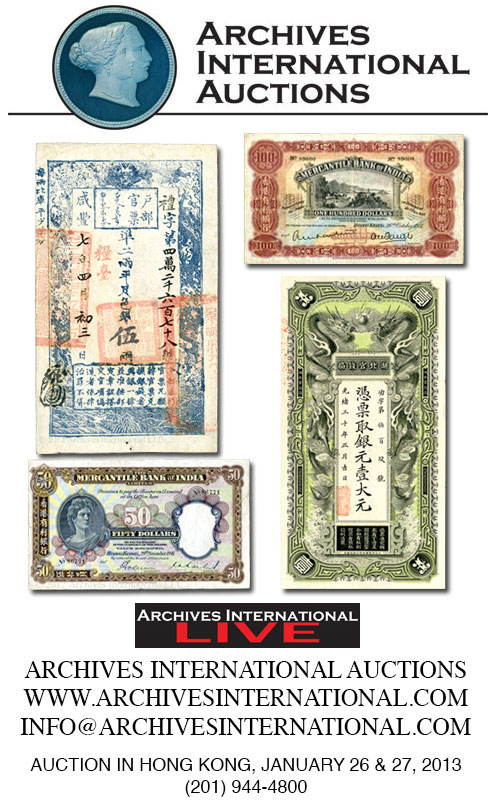
About UsThe Numismatic Bibliomania Society is a non-profit organization promoting numismatic literature. For more information please see our web site at coinbooks.org SubscriptionsThose wishing to become new E-Sylum subscribers (or wishing to Unsubscribe) can go to the following web page link MembershipThere is a membership application available on the web site Membership Application To join, print the application and return it with your check to the address printed on the application. Membership is only $15 to addresses in the U.S., $20 for First Class mail, and $25 elsewhere. For those without web access, write to: David M. Sundman, Secretary/TreasurerNumismatic Bibliomania
Society AsylumFor Asylum mailing address changes and other membership questions, contact David at this email address: dsundman@LittletonCoin.com SubmissionsTo submit items for publication in The E-Sylum, just Reply to this message, or write to the Editor at this address: whomren@coinlibrary.com
BUY THE BOOK BEFORE THE COINYou won't regret it! |
- WAYNE'S WORDS: THE E-SYLUM DECEMBER 16, 2012
- KOLBE & FANNING AUCTION FEATURES CLAIN-STEFANELLI ARCHIVES
- LAKE BOOKS 113TH MAIL-BID SALE CLOSES JANUARY 22, 2013
- SKLOW MAIL BID SALE #18 CLOSES FEBRUARY 2, 2013
- EL SITIO NO. 5 PUBLISHED
- NUMISMATICA GENEVENSIS AUCTION REVIEW
- MORE ON SLABBING NORWEB COINS
- MORE ON CONTACT MARKS
- NOTES FROM E-SYLUM READERS: DECEMBER 16, 2012
- MORE ON THE NUMISMATIC GREATS
- DICK JOHNSON COMMENTS ON MORGAN'S PRIVATE SKETCHBOOK
- MORE ON LABOR EXCHANGE NOTES
- LIBERTY DOLLAR SALES BANNED ON EBAY
- A SMARTPHONE APP FOR COUNTERFEIT DETECTION
- ARTICLE PROBES 1985 MURDER OF DEAK-PERERA FOUNDER
- THE JAMES WEAVER HAIR GOODS ADVERTISING NOTE
- WAYNE'S NUMISMATIC DIARY: DECEMBER 16, 2012
- THE MARK HILLARY 1796 HALF CENT
- CALIFORNIA WOMAN INHERITS $7 MILLION GARAGE GOLD HOARD
- JUNO MONETA, GODDESS OF MONEY
- THE WORLD'S STRANGEST CURRENCIES
- FEATURED WEB PAGE: FOUR DOLLAR STELLA
WAYNE'S WORDS: THE E-SYLUM DECEMBER 16, 2012

New subscribers this week include Roberto Jovel, courtesy of Alan Luedeking, Corleen Chesonis, Alexandre De Barros and George Watson. Welcome aboard! We have 1,616 email subscribers, plus 202 followers on Facebook.
When we were down to just a couple advertisers a few issues back, I started to wonder about the level of interest and support for The E-Sylum. I needn't have worried. One regular advertiser found it hard to believe others didn't do the same - "It's cheap and effective". I sent some emails to see if there was interest in advertising, and the response was overwhelming. Tonight's issue has the largest number and volume of ads in our history.
Some of these are just one to three issue placements, but others may continue through many weeks. In fact, Whitman Publishing will be back for the whole year of 2013. So I'd like to publicly thank our advertisers for their support, and encourage our readers to in turn support our advertisers. Check out their web sites, bid in their sales, and help build your own collections and library.
This week we open with updates on three upcoming numismatic literature sales. Other topics include George Morgan and what his sketchbook reveals about his skills, contact marks, and an app for detecting counterfeit money.
To learn more about Melvil Dewey, Vladimir and Elvira Eliza Clain-Stefanelli, Labor Exchange Notes, the Christian Industrial Exchange, and the major industry firm that was a front for the CIA, read on. Have a great week, everyone!
Wayne Homren
Editor, The E-Sylum
KOLBE & FANNING AUCTION FEATURES CLAIN-STEFANELLI ARCHIVES
 Kolbe & Fanning Numismatic Booksellers will be holding their 2013 New York Book Auction at the Waldorf-Astoria Hotel in New York City on Saturday, January 12 in conjunction with the New York International Numismatic Convention. While the sale includes books and other publications spanning the entire range of numismatics, some of the most important material offered includes the personal papers of Vladimir and Elvira Eliza Clain-Stefanelli.
Kolbe & Fanning Numismatic Booksellers will be holding their 2013 New York Book Auction at the Waldorf-Astoria Hotel in New York City on Saturday, January 12 in conjunction with the New York International Numismatic Convention. While the sale includes books and other publications spanning the entire range of numismatics, some of the most important material offered includes the personal papers of Vladimir and Elvira Eliza Clain-Stefanelli.
Vladimir Clain and Elvira Eliza Olinescu began their numismatic careers in Europe. The couple’s early lives were continually affected by warfare, with Elvira’s family fleeing their native Romania in her youth and her formal education at the Cernãuți university ceasing with the 1940 Soviet invasion of northern Bukovina. In 1939, she had married Vladimir Clain (born Waldemar Günther Klein). Vladimir held a doctoral degree, being a student of history and archaeology—and increasingly of numismatics. Their lives were upended when they were sent to the Buchenwald concentration camp by the Germans in 1943. They survived a year and a half in Buchenwald before being released. With Romania being under Soviet rule, they decided to live in Italy, where they worked for the Santamaria firm. At some point, they began to go by Clain-Stefanelli, Stefanelli being Vladimir’s mother’s maiden name.
In 1951, they moved to the United States, where they would live out the remainder of their lives. Among other firms, the couple worked for Hesperia Art and Stack’s, and were instrumental in the development of the latter’s Coin Galleries subsidiary, with Elvira writing their first sale catalogue (July 13, 1954) and Vladimir managing the operation. Vladimir was appointed curator of the National Numismatic Collection in October 1956. Elvira joined him there the following year, and succeeded Vladimir upon his death in 1982. During their tenures, the numismatic collection housed in the National Museum of American History grew from some 65,000 objects to over 1.6 million pieces. Elvira Clain-Stefanelli died in 2001. The two left behind a legacy of scholarship and curatorship that continues to influence numismatics today.
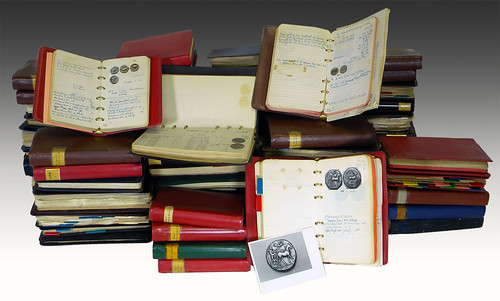
Included in the personal archives of this extraordinary couple are:
—Vladimir’s earliest serious numismatic work, including his doctoral dissertation on the ancient coins of Callatis.
—Early notes and historical writings by Elvira.
—Vladimir’s numismatic correspondence from 1948 to 1951, when the couple were living in Italy. Includes letters from many of the most notable numismatists of the period.
—An extraordinary group of 77 binders filled with handwritten notes compiled by Elvira, including ten notebooks constituting a major unpublished work on Roman republican coins.
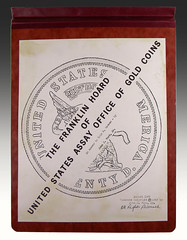 —Vladimir’s extensive archive of materials on the USAOG controversy, including his copy of John J. Ford, Jr.’s rare PNG report. This is the most complete archive of material on the subject ever offered for public sale.
—Vladimir’s extensive archive of materials on the USAOG controversy, including his copy of John J. Ford, Jr.’s rare PNG report. This is the most complete archive of material on the subject ever offered for public sale.
—Original manuscripts and typescripts of several of the couple’s published works.
—Their archives on early American medals.
The Clain-Stefanelli archives are being offered in a number of different lots in the sale, allowing specialists to pursue those parts of the archives in which they are most interested.
For more information on the sale, or to download a PDF version of the printed catalogue, please go to the firm’s website at www.numislit.com. Live online bidding will be provided by the-saleroom.com (prior registration required). For full bidding instructions, please see the catalogue and read the terms of sale.
LAKE BOOKS 113TH MAIL-BID SALE CLOSES JANUARY 22, 2013
Lake Books announces that its 113th mail-bid sale of numismatic literature is now available for viewing on its web site at www.lakebooks.com/current.html
The sale features selections from the libraries of Bill Eckberg, a prominent Early American Coppers luminary and more from the large and varied library of David E. Litrenta
The 465-lot catalog has some rare material including the photographic plates of the Waldo Newcomer sale that were sold in the Champa II auction by Bowers in 1995, an original Doughty on the "Cents of the United States", an 1839 Joseph Felt on "Massachusetts Currency" plus reference works covering Tokens and Medals, Paper Money, and many issues of "The Asylum".
The sale has a closing date of Tuesday, January 22, 2013 at 5:00 PM (EST) and your bids may be placed by email, FAX, telephone or US Mail until that time.
Good Luck with your bidding ! Fred
Lake Books
6822 22nd Ave. N.
St. Petersburg, FL 33710
727-343-8055 Fax 727-381-6822
SKLOW MAIL BID SALE #18 CLOSES FEBRUARY 2, 2013
The catalog for our Numismatic Literature Mail Bid Sale # 18: February 2, 2013 is posted on our web site. The sale contains 1,088 lots of very diverse material; literally something for everyone!
Printed catalogs will be mailed to all those on our mailing list starting December 26th. Enjoy the catalog, enjoy the holidays, double check your bid sheets, and bid early!
David Sklow-Fine Numismatic Books
P.O. Box 6321
Colorado Springs, CO 80934
PH: 719-302-5686
FAX: 719-302-4933
EMAIL: numismaticbooks@aol.com
WEB: FineNumismaticBooks.com

EL SITIO NO. 5 PUBLISHED
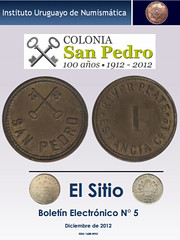 The Instituto Uruguayo de Numismática has published the fourth issue of their electronic publication El Sitio. The cover article is on the centennial of San Pedro colony.
The Instituto Uruguayo de Numismática has published the fourth issue of their electronic publication El Sitio. The cover article is on the centennial of San Pedro colony.
To read the complete issue, see:
www.monedasuruguay.com/bib/bib/sitio05.pdf
NUMISMATICA GENEVENSIS AUCTION REVIEW
Regarding Numismatica Genevensis, Ursula Kampmann writes:
There are always many record prices. And it really was interesting. They sold a complete set of the first Umayyad gold dinars for 1.3 mio. Swiss Franks. This is bad news for the traditional market place of Islamic coins in London. I have the feeling the market shifts to Geneva. But there were other very interesting results especially for the ancient coins.
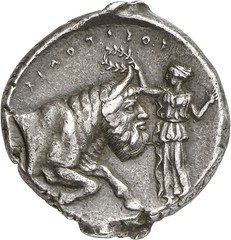
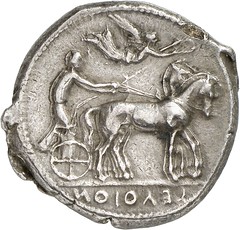
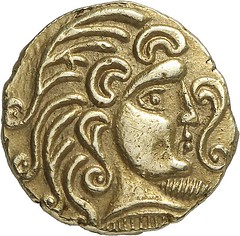
For more information on Numismatica Genevensis, see: www.ngsa.ch
MORE ON SLABBING NORWEB COINS

Bob Van Arsdell writes:
I can offer a bit of insight into the packaging of the Norweb coins. I bought some of the Ancient British material in Spinks' sale number 45 on 13 June 1985. These coins were (obviously) not slabbed, so we can say that not all the Norweb material was slabbed.
The coins I received came with the original Norweb 2X2s. These have a distinctive spider web motif printed on the flap. It would be a simple matter to identify the provenance if the coins managed to stay with their envelopes.
Dave Lange of NGC writes:
I believe I can shed some light on the question raised of how NGC was able to attribute a Canadian coin to the Norweb Collection. NGC will add a provenance to a coin if it is submitted in the sealed flip from that sale or may be plate matched with the original auction catalog. In rare instances we have done this for coins attributed to a particular collection in a subsequent auction, as long as we have faith in that company's cataloger.
It usually falls to me to do this for American pieces, while our world grading room attributes any coins or tokens made outside of what is now the USA.
To read the complete article, see: QUERY: WERE MANY NORWEB CANADIAN LARGE CENTS SLABBED? (www.coinbooks.org/esylum_v15n51a11.html)
MORE ON CONTACT MARKS
Joe Boling writes:
I'm with you on contact marks - small dings that are not as obvious and distracting as full-fledged silver dollar bag marks.
Bill Eckberg writes:
I'll be brave and stand with you. "Contact marks" means "damage from touching other things". The type of touching isn't specified, so bag marks and cabinet friction could BOTH be thought of as types of contact marks. However, I think the general understanding would be that contact marks mean marks other than friction wear.
Pablo Hoffman writes:
The operative word is "mark," as opposed to "wear." A mark is caused by a discrete contact localized in a distinct location, and is distinguished from wear, which is generalized across the surface of the item. A coin might have a thousand bag marks and no wear, and therefore remain technically uncirculated.
I'm with you.
Peter Mosiondz, Jr.writes:
As a collector and numismatist of nearly sixty years I’ll offer my personal viewpoint; “Basically, any source of dings, dents, and scrapes that mar coins as a result of contact with other coins can be called contact marks. The larger the coin, the more susceptible it is to this type of damage. In many instances collectors and dealers refer to these contact marks as “damage”. The grading houses detract “points” from the coin’s technical grade according to the number and placement of these contact marks”.
I also offer the ANA’s definition of contact marks; “These are tiny nicks, dings, lines, and other intrusions into the metal surface of a coin created by coming into contact with other coins (such as in a cloth bag), in pocket change, while being stored or moved, or, in some instances, careless handling by collectors. A coin with few or no contact marks is a candidate for a high grade, while a coin with extensive contact marks must be placed in a lower category”.
It is important to consider the fact that most contact marks on our earlier coins, especially the Large Cents, came from jostling about and coming into contact with other coins well after leaving the Mint.
Others may have differing opinions and that is what makes our great hobby so fascinating.
Mark Van Winkle writes:
The person who set me straight about the term “contact marks” was Walter Breen. He was most emphatic that contact marks happened to proof coins, and abrasions happened to circulation strikes. Once I thought about it, there seemed to be a great deal of logic to this. Since then that is how I have used the terms and have encouraged the other Heritage catalogers to do the same.
I would like to say the Heritage catalogers have all fallen in line with this thinking, but we do occasionally slip and say a proof has abrasions or a business strike has contact marks. Neither is wrong in the absolute sense. But I have incorporated this on the Style Sheet for catalogers. To me it makes sense that a proof coin would have incidental contact from other coins or other objects. Coins struck for circulation are abraded from coin-to-coin contact even while in the mint. I can certainly understand that this would be a fine line for some.
Regarding the alternate meaning, I do not understand how “contact marks” can apply to cabinet friction. We have perfectly good words for that: friction and rub. If it is slight, then “high-point friction.” However, such a coin could have high-point friction but be free from abrasions or contact marks.
To go further down the rabbit hole, Pablo Hoffman states a coin might have a thousand bag marks, but no wear and still be Uncirculated. My answer is an emphatic, “Yes, but … “ When you examine thousands of coins, many of which are in the AU58-MS62 range, one begins to understand the nature of third-party grading. It is a value-based system. Yes, the coin may be peppered with innumerable abrasions and have no actual rub from circulation, yet still be graded AU58. This is because the market values that coin as an AU58, not necessarily because it has actual friction from handling. So, third-party grading backs out the grade of a coin from how the market values it.
To read the earlier E-Sylum article, see: QUERY: CONTACT MARKS: WHERE AND HOW? (www.coinbooks.org/esylum_v15n51a12.html)
NOTES FROM E-SYLUM READERS: DECEMBER 16, 2012
2013 COIN OF THE YEAR QUESTIONS AND CORRECTION
Regarding last week's item about the Coin of the Year (COTY) awards,
Jim Duncan writes:
The French piece is "from Clove to Charlemagne" - is that Clovis? I've seen it in the article you quoted but Clove seems an odd name to me, maybe I am at fault.
Bruce Perdue writes:
In the article about the 2013 Coin of the Year Awards you have the "Best Trade Coin" twice but on is obviously the basketball coin and the other looks to be an owl...

Most Popular Coin
National Bank of Mongolia – 2011 Ural Owl 500 Togrog Silver Coin
A close up of the Ural Owl is shown with its eyes created from two dark Swarovski Elements.
Struck in 99.9% silver with an antique finish, the weight is 1 troy ounce and diameter is 38.61 mm. The mintage is indicated at 2,500 pieces.
To read the earlier E-Sylum article, see: 2013 COIN OF THE YEAR AWARD WINNERS (www.coinbooks.org/esylum_v15n51a17.html)
Happy Birthday, Melvil Dewey
It's the birthday of Melvil Dewey, born in Adams Center, New York (1851). He put himself through college by working in the library, and he felt it was appallingly disorganized. There was no consistent system across libraries. Some numbered shelves, some arranged books by size just to look nice, and some libraries tried to alphabetize the whole library, which meant that every time they got a new book they had to redo the entire system. He knew there had to be a better way, so he worked on a system of categories and sub-categories, assigning each a system of numbers. And he came up with the Dewey Decimal System, which is still used today in many libraries, a series of classifications divided and subdivided into subjects and a decimal number assigned to each book.
To read the complete article, see: Dec. 10, 2012 (writersalmanac.publicradio.org/index.php?date=2012/12/10)
Maine Depression Scrip Images Sought
Max Lynds (max@pwless.net writes:
I am putting together a booklet an Maine Depression Scrip and am looking for scans of examples.
No God But Allah Overstamp

PAN eNews Promotes The E-Sylum
In the Nov /Dec 2012 issue of PAN eNews (published by the Pennsylvania Association of Numismatists), editor Pat McBride writes:
PAN member, Wayne Homren is the editor of quality enewsletter that is filled with the best and the most comprehensive numismatic knowledge contributed and interactively supported by their notable subscribers. If you are looking for in depth topics and are a seasoned numismatist then this is a good source to take advantage of.
Pat appended a note I'd recently sent to some Pittsburgh-area numismatists inviting them to subscribe:
For 15 years I’ve been publishing a weekly email newsletter for numismatic bibliophiles, researchers and just plain collectors. We have over 1,600 subscribers worldwide. It goes out every Sunday evening with about 20 or so articles covering every numismatic topic under the sun. Nearly everyone finds something of interest in every issue. The Numismatic Bibliomania Society sponsors it, but you don’t have to be a member – it’s free to all.
Thanks for the shout-out!
Three-Dollar Gold Piece Held With Sublime Tenacity
Dave Bowers forwarded this image of an item from the Meriden (CT) Daily Republican April 11, 1888. Thanks!
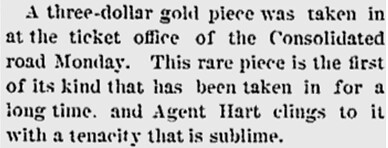

MORE ON THE NUMISMATIC GREATS
Regarding last week's item on the picture gallery of U.S. numismatic greats from Collector's Universe, Jim Duncan of New Zealand writes:
It was interesting to read the list of "greats" - but I was surprised to find Richard S Yeoman's name absent. Is he no longer a recognised great? His was the first coin book I ever bought back in the 60s.
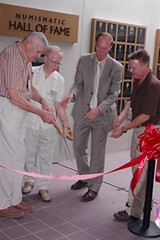 Well, that's not any "official" list, just a compilation of images found in various Collector's Universe posts. There is a Numismatic Hall of Fame at the American Numismatic Association, and Richard Yeoman was inducted in 1978.
Well, that's not any "official" list, just a compilation of images found in various Collector's Universe posts. There is a Numismatic Hall of Fame at the American Numismatic Association, and Richard Yeoman was inducted in 1978.
By the way, no one was able to identify the two mystery numismatists I pictured last week. So here’s a hint. The first one was NOT a U.S. citizen, and lived in a palace. The second one was a controversial academic.
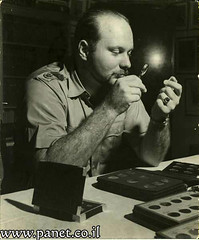

For more information, see: Numismatic Hall of Fame (www.money.org/membership/awards/numismatic-hall-of-fame.aspx)
To read the earlier E-Sylum article, see: PICTURE GALLERY OF U.S. NUMISMATIC GREATS (www.coinbooks.org/esylum_v15n51a16.html)
DICK JOHNSON COMMENTS ON MORGAN'S PRIVATE SKETCHBOOK
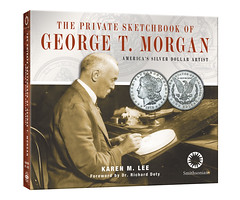 Kudos to Karen Lee and the Whitman staff for the attractive book just published, "The Private Sketchbook of George T. Morgan, America's Silver Dollar Artist." It is visually appealing with its photo album treatment of every page.
Kudos to Karen Lee and the Whitman staff for the attractive book just published, "The Private Sketchbook of George T. Morgan, America's Silver Dollar Artist." It is visually appealing with its photo album treatment of every page.
The author did an excellent job tracking down facts on the artist before he came to America, starting his career in England. To this was added photographs, copies of documents, illustrations of coins and medals, plus artifacts connected to the artist's professional life.
However, I wish to comment on the sketchbook itself, as this gives insight to the artistic acumen of the former U.S. chief engraver. The sketches are uneven. But this is what a sketchbook should be, to test a visual concept before even touching or transferring a design to clay, plaster or the surface of a die.
Some sketches give dramatic evidence to Morgan's mastery of draughtmanship. `I was highly impressed with the acanthus leaf ornament on page 118 complete with their crenulated edges. Note the shading. This is ideal for a graphic two-dimensional drawing. But it is not the precursor of a glyptic three-dimensional bas-relief design for a coin or medal.
Shaded drawings do not transfer well to modulated relief of a coin or medal. What is preferred is a hard line drawing outlining the portrait or device., preferably a solid line. Detail is added later in the modelling stage.
The drawing is called a cartoon. (These were not named after comic cartoons, it's the other way round. Cartoon drawings were employed by medallists for centuries, comics were a later invention and took the name from this existing art technique.)
Some of Morgan's sketches shown here intended for medals (example page 96) show a lack of a hard edge outline for a portrait or device. He has drawn over and over some guidelines intended for such device elements. These somewhat fuzzy lines indicate somewhat fuzzy thinking. How much better would it have been to make one single firm line to outline a device element.
Some master medallists -- as Saint-Gardens -- eschewed the drawing stage entirely. He preferred to sketch in clay right from the beginning. Thus he began thinking in three dimensions instead of two, later to be transferred to three.
Other American medallists, like the Frasers, preferred to sketch (as do most medallic artists) to outline the device, and often the lettering. This aids the observance of the total interspatial relationship of all elements.
Thus Morgan was an excellent technician. He could transfer his drawing into the rise and fall of relief, creating the modulated relief for a coin or medal model. It was his medallic concepts, evidenced by his drawings shown here, that were stiff, formal, prim and proper -- perhaps due to his stiff British training. He lacked a freer, more creative medallic style we see in American medallists.
o Note to authors: If you are writing about any American artist -- and I greatly encourage this like Karen Lee did here -- ask me for a listing of all the work by that artist. I have a databank on 3,152 American coin and medal artists I would gladly share the listing of an artist with you. Take a look at Appendix A in this book (pages 137-147). This is typical of what I can furnish, which I did for this book, though this is a more lengthy one. Contact: dick.johnson@snet.net
THE BOOK BAZARRE
MORE ON LABOR EXCHANGE NOTES
The so-called “gay nineties” was actually a period of economic hard times for American farmers and industrial workers. Employment shrank and credit became tight. Many turned to cooperative ventures as a way to make ends meet. They believed that through collective ownership and control, they could earn their living without having to rely on employers, financiers and middlemen to provide them with work. Mutual benefit, rather than profit, was to be the goal of the cooperative movement.
To pursue this goal, a Missouri farmer, Giovanni B. DeBernardi (1831-1901), organized the Labor Exchange in 1889 at Independence. DeBernardi, born in Italy, had lost most of his farm to foreclosure during the Panic of 1873. Through lectures, promotional tracts and publication of a newspaper, DeBernardi drew a respectable number of adherents to his organization. By 1896 it had an estimated 6,000 members in 135 chartered branches throughout 32 states. It ultimately grew to more than 15,000 members in 311 branches, including one in Toronto, then declined and went out of existence after the turn of the century. (In Freedom, Kansas, an actual socialist colony based on DeBernardi’s principles was organized on 160 acres of farmland, but this colony was not formally associated with the Labor Exchange.)
According to Gordon S. Watkins, a labor economist, this is how the exchange system worked:
Members of the association were privileged to bring to the exchange any commodity they desired, and to receive payment in the form of a labor check for an equivalent value in the local wholesale market, where goods would be purchased at retail prices. Nonmembers could trade at the exchange either by use of labor checks or legal money.
The check illustrated is good for one-tenth of a “unit” of labor. In his studies, Steve Whitfield says that a “unit” was worth a day’s labor and that the checks were issued in denominations of 1/100, 1/20, 1/10, ¼, ½, 1, 2, 5, 10 and 20 “units”. Presumably that meant that, say, a carpenter member who spent a day making a cabinet would receive a 1-unit check for bringing the cabinet to the exchange, and could either hold the check as money or spend it by taking out commodities on which other members had worked an equivalent amount of time to produce. There may even have been a “shop book” for setting standard values for the commodities, but this is not known.
I wrote two major articles on these notes which were published in Bank Note Reporter. The first was in the February 1996 issue. The second was published sometime after March 1997. I have been recording Labor Exchange notes since the 1970's because the headquarters was in Missouri. There is a note on the branch at Marshall, MO but none are known for Branch #1 at Kansas City, MO. I have recorded notes on 48 different branches (49 including the previously unknown branch in last Sunday's E-Sylum) in 17 states.
Three types of notes have been recorded in various sources:

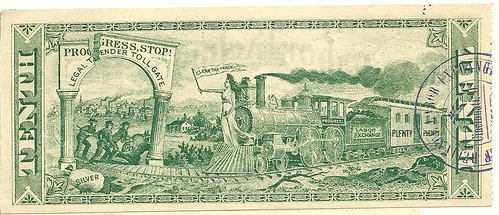
1) Obv: globe center; seated woman left end. Rev: train approaching marble arch.
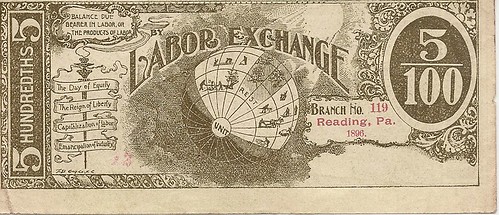
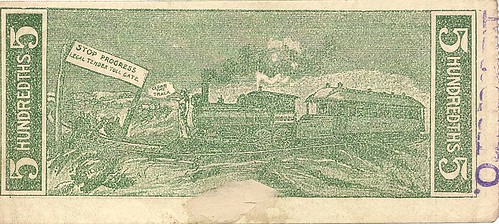
2) Obv: globe center; banner left end. Rev: train approaching wooden arch.
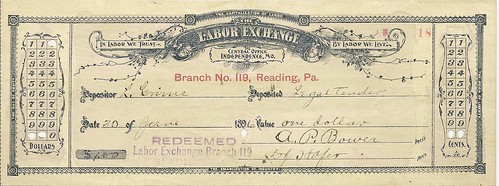
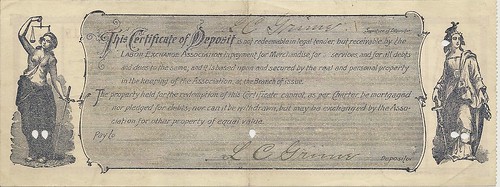
3) No vignette; punch boxes for dollar amounts left end, cent amounts right end.
In 2005 I purchased on eBay a previously unknown type (to me at least) of Labor Exchange note, smaller than the others, printed in blue on the front and orange on the back. Obverse has workman with globe on his shoulders left, hand holding a torch right. No vignette on back. The note is for 10/100 and is from the "Self Reliance Branch No. 220 of the Labor Exchange" at Cincinnati, Ohio. The undated note calls itself a "Balance Check" or "Due Bill".

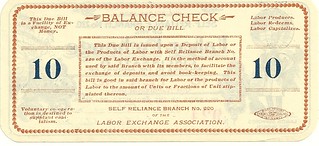
4) "Balance Check" or "Due Bill" Note
Probably something over 90 percent of Labor Exchange notes are the globe and train type. The punch box type is much rarer. The Due Bill I have is the only one I have ever seen of that type. Some of the state catalogs of obsolete notes list these Labor Exchange notes. They are not in the Haxby catalog of obsolete notes because Haxby decided to list only BANK notes and not scrip. I talked to him awhile back. He's thinking of doing another edition of the obsolete book. It has been out of print for years and sells now for $600 to $1000. Krause recently released a version of the original book on CD. Listing just the scrip would require another set of volumes.
Bruce Perdue of the Central States Numismatic Society adds:
The upcoming Neil Shafer book on emergency scrip issues of 1893 to 1915 is another book project that benefited from a CSNS numismatic book grant.
Labor Exchange Scrip;
The Christian Exchange of Detroit, Michigan
By Steve Whitfield
My article in the Nov / Dec issue of Paper Money about the Labor Exchange branch system of the 1890s elicited several interesting responses from readers. It also turned up a dynamite note in a new denomination. Friend Larry Falater sent me a copy of the note illustrated here. Nothing like it had been seen before, to my knowledge. The note was issued by surely one of the last branches to be organized. The Labor Exchange organization had pretty much died out by the turn of the twentieth century, although some branches continued operations into the teens. DeBernardi, the founder, had died in 1901. This note proves that branches were still being chartered as late as 1905.
Branch # 335 of Detroit Michigan (the previous high charter was #318.) was self named “The Christian Industrial Exchange”. This note is an unredeemed certificate of deposit for 3 units of labor. It was apparently used in an attempt to recruit new members to the exchange. It is specifically “not redeemable in legal tender”, although legal tender could be deposited at the exchange and later be redeemed as labor units for goods or services.
The back of the note explains why the note was still “in circulation” and advertises services provided by the exchange to its members.. The purpose of the organization was “both cooperative and benevolent; consistent with the true principals of Christian brother-hood.”. The note boldly states “THE CAPITALIZATION OF LABOR IN THE NAME OF CHRIST”. The branch was located at 15-17 Wilcox ST., in Detroit. And the telephone # was M.4401-J. (Collectors from Detroit may want to try this number to see if the Exchange is still there.)
The Heritage paper money sale, in January, included one of the rare certificates of deposit on Branch #277, Gray Cloud Island, Minnesota. Ms. Harriet Mavis had deposited $2.50 in US legal tender in November, 1897. These are attractive notes/CDs with great end vignettes on the back. I, of course was outbid on the note which went for $345! Aari Jacob reported acquisition of a Labor Exchange seal from Branch #14, at Dilley, Oregon and several others reported unlisted notes, or submitted spelling error changes. Meanwhile, Hugh Shull turned up a previously unreported, but predicted, piece on Salina Kansas that I was happy to add to my collection.
So thanks to the responders and please let me know if you turn up any new Labor Exchange notes or related items.
To read the earlier E-Sylum article, see: THE LABOR EXCHANGE NOTES OF GIOVANNI DEBERNARDI (www.coinbooks.org/esylum_v15n51a15.html)
LIBERTY DOLLAR SALES BANNED ON EBAY

At the request of the U.S. Secret Service, eBay has begun purging the online auction site of listings offering for sale Liberty Dollar medallions in gold, silver, platinum and copper.
Officials at eBay indicate the systematic removal beginning Nov. 29 of the listings is intended to conform with its policy implemented Feb. 20 banning the listing of counterfeits and replicas on eBay.com.
In emails sent by eBay to sellers whose listings for Liberty Dollars were canceled, officials at the online auction site expressed their regrets for having to take the action.
Contacted by Coin World, eBay spokesman Ryan Moore offered the following comment: “The listings for Norfed Liberty Dollars have been removed as they have been deemed counterfeit by the United States Secret Service. Counterfeits are illegal and not welcome on any of eBay’s sites.”
NORFED is more formally known as the National Organization for the Repeal of the Federal Reserve Act and the Internal Revenue Code. The group issued Liberty Dollar medallions as an alternative to Federal Reserve notes, and advocated their commercial use.
Dave Gillie, who began buying and selling Liberty Dollars in 2001 and later became a regional currency officer for NORFED, said Dec. 5 that he had eight of his listings for Liberty Dollars canceled on Nov. 29.
Gillie still accepts Liberty Dollars at his Gillie’s Coney Island restaurant in Mount Morris, Mich., in payment for meals.
The dealer was perplexed by the government’s characterization of Liberty Dollars as counterfeits. Gillie said in a Dec. 5 email to Coin World that out of respect for eBay’s “coerced” decision he will not list Liberty Dollars for sale at the website until “they change their policy again.”
Gillie estimates he has sold and exchanged thousands of Liberty Dollars in the years he’s been involved with them. Gillie says he’s also purchased hundreds of Liberty Dollars from former NORFED regional currency officers leery about what legal action authorities could take against those own Liberty Dollars.
Several questions remain unanswered by the Secret Service:
➤ Are the pieces legal to own, sell, distribute or even exhibit for educational purposes at a coin show or other venue?
➤ Will federal law enforcement authorities seek to seize any of the tens of thousands of Liberty Dollars still in private hands?
To read the complete article, see: Liberty Dollars ban goes into effect at eBay (www.coinworld.com/articles/liberty-dollars-ban-goes-into-effect-at-ebay/)
To read a related earlier E-Sylum article, see: LIBERTY DOLLAR FOUNDER VON NOTHAUS AWAITS HIS FATE (http://www.coinbooks.org/esylum_v15n45a11.html)

A SMARTPHONE APP FOR COUNTERFEIT DETECTION
German smartcard and security printing group Giesecke & Devrient has developed a security feature called MAGnite that allows mobile phone users to verify banknotes authenticity. The system uses interaction between special colour pigments and magnets such as those used in mobile phone speakers. The colour pigments align along the magnetic field lines when the note is placed over a magnet and make the feature visible through a high-contrast change of the image on the note. MAGnite works with other magnets, such as those in store checkout theft-prevention systems. The head of G&D's banknote printing division, Bernd Keummerle, said that due to its ease of use and easily recognised optical effect, MAGnite is a sound alternative to watermarks and security threads for the general public.
To read the complete article, see:
G&D enables mobile phones to check banknote authenticity
(www.telecompaper.com/news/gandd-enables-mobile-phones
-to-check-banknote-authenticity--913340)
To read the earlier E-Sylum article, see: NOTES FROM E-SYLUM READERS: DECEMBER 2, 2012: Is There an App for Counterfeit Detection? (www.coinbooks.org/esylum_v15n50a08.html)
ARTICLE PROBES 1985 MURDER OF DEAK-PERERA FOUNDER
Nearly 30 years after a former CIA money changer was murdered by a homeless bag lady, new details have emerged that suggest he may actually have been assassinated.
Nicholas L. Deak was nicknamed the 'James Bond of money,' for his suave, confident air and his central role in the 'black ops' world of clandestine CIA operations from World War II until the 1980s.
Following the war, the CIA helped him found Deak-Perera as a front company to help it move money around the world, funding armed coups and friendly regimes, all while insulating the US government.
Deak, a Ph.D. economist, also built it into a legitimate bank, offering foreign currency trades - including American families who often bought its bundled packs of French francs and German marks.
But in 1985, when 80-year-old Deak and his secretary were shot at close range by Lois Lang, his company had been investigated for laundering money and the CIA had abandoned him.
To read the complete article, see:
Was CIA financier-turned Wall Street banker assassinated by the bearded bag lady? New evidence may solve mystery of 1985 shooting
(www.dailymail.co.uk/news/article-2245682/Nicholas-Dea
-Colleague-questions-murder-CIA-financier-killed-homeless-woman.html)
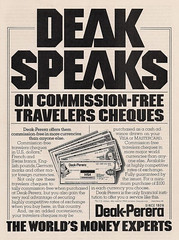 Deak-Perera had been headquartered on the building’s 20th and 21st floors since the late 1960s. Nick Deak, known as “the James Bond of money,” founded the company in 1947 with the financial backing of the CIA. For more than three decades the company had functioned as an unofficial arm of the intelligence agency and was a key asset in the execution of U.S. Cold War foreign policy. From humble beginnings as a spook front and flower import business, the firm grew to become the largest currency and precious metals firm in the Western Hemisphere, if not the world. But on this day in November, the offices were half-empty and employees few. Deak-Perera had been decimated the year before by a federal investigation into its ties to organized crime syndicates from Buenos Aires to Manila. Deak’s former CIA associates did nothing to interfere with the public takedown. Deak-Perera declared bankruptcy in December 1984, setting off panicked and sometimes violent runs on its offices in Latin America and Asia.
Deak-Perera had been headquartered on the building’s 20th and 21st floors since the late 1960s. Nick Deak, known as “the James Bond of money,” founded the company in 1947 with the financial backing of the CIA. For more than three decades the company had functioned as an unofficial arm of the intelligence agency and was a key asset in the execution of U.S. Cold War foreign policy. From humble beginnings as a spook front and flower import business, the firm grew to become the largest currency and precious metals firm in the Western Hemisphere, if not the world. But on this day in November, the offices were half-empty and employees few. Deak-Perera had been decimated the year before by a federal investigation into its ties to organized crime syndicates from Buenos Aires to Manila. Deak’s former CIA associates did nothing to interfere with the public takedown. Deak-Perera declared bankruptcy in December 1984, setting off panicked and sometimes violent runs on its offices in Latin America and Asia.
Lois Lang had been watching 29 Broadway for two hours when a limousine dropped off Deak and his son Leslie at the building’s revolving-door rear entrance. They took the elevator to the 21st floor, where Lauder informed Deak about the odd visitor. Deak merely shrugged and was settling into his office when he heard a commotion in the reception room. Lang had returned. Frances Lauder let out a fearful “Oh—” shortened by two bangs from a .38 revolver. The first bullet missed. The second struck the secretary between the eyes and exited out the back of her skull.
Deak, fit and trim at age 80, bounded out of his office. “What was that?” he shouted. Lang saw him and turned the corner with purpose, aiming the pistol with both arms. When she had Deak in her sights, she froze, transfixed. “It was as if she’d finally found what she was looking for,” a witness later testified. Deak seized the pause to lunge and grab Lang’s throat with both hands, pressing his body into hers. She fired once next to Deak’s ear and missed wide, before pushing him away just enough to bring the gun into his body and land a shot above his heart. The bullet ricocheted off his collarbone and shredded his organs.
Deak crumbled onto the floor. “Now you’ve got yours,” said Lang. A witness later claimed she took out a camera and snapped photographs of her victim’s expiring body. The bag lady then grabbed the banker by the legs, dragged him into his office, and shut the door.
Lois Lang was tried, convicted and institutionalized under the assumption that she was mad. According to state psychiatrists, she targeted Deak because of random delusions, and her handlers were figments of her cracked imagination. The first judge to hear Lang’s case ruled her unfit for trial and sent her to Kirby Forensic Psychiatric Center. She was sentenced eight years later, in 1993, when a state Supreme Court justice convicted her on two counts of second-degree murder and sent her to the Bedford Hills Correctional Facility upstate, where she remains. Conspiracy was never part of the trial.
Arkadi Kuhlmann has long scoffed at the court’s conclusion. Kuhlmann, then 35 and newly in charge of Deak-Perera’s Canadian operations, became CEO after Deak’s death. Like his Deak-Perera colleagues, he understood that many criminal account holders had lost millions when the firm went bankrupt in 1984. Deak’s subsequent murder, he felt, was no coincidence.
“I never believed that the whole thing was random,” said Kuhlmann, in an interview with Salon. Ditto the government inquiry that triggered the collapse preceding Lang’s rampage. “We were the CIA’s paymaster, and that got to be a little bit embarrassing for them,” he said. “Our time had passed and the usefulness of doing things our way had vanished. The world was changing in the ’80s; you couldn’t just accept bags of cash. Deak was slow at making those changes. And when you lose your sponsorship, you’re out of the game.”
To read the complete article, see: James Bond and the killer bag lady (www.salon.com/2012/12/02/better_than_bourne_who_really_killed_nick_deak/)
THE JAMES WEAVER HAIR GOODS ADVERTISING NOTE
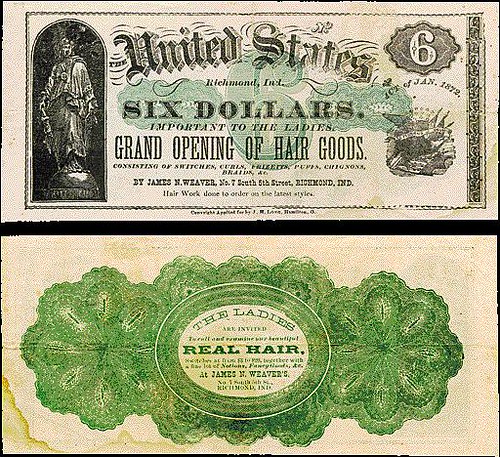
Advertising notes have always been an interest of mine. These notes were typically designed to at least remotely resemble legitimate notes in circulation. Some were better likenesses than others but the goal was the same — capture the recipient’s attention long enough to deliver the issuer’s advertising message.
Some advertising notes served only this purpose while others actually offered the holder some financial incentive to make a purchase.
James N. Weaver of Richmond, Ind., issued a $6 advertising note sometime around 1872.
Although the note is clearly a nongenuine denomination, it bears at least a passing resemblance to the 1863 $5 legal tender note that was still in circulation when these advertising notes were being passed out.
The design was not close enough to attract the attention of the Secret Service but just enough to catch the attention of a potential customer.
While most of advertising notes were issued by dry goods merchants and other similar firms, it’s always interesting to run across the occasional “odd” issuer. Weaver and his notes fit the bill.
According to the 1870 and 1880 census, Weaver was a “barber.” In addition, another family member or boarder was listed as a “hairdresser” in both census records.
To read the complete article, see: Oddball advertising note (www.coinworld.com/articles/oddball-advertising-note/)
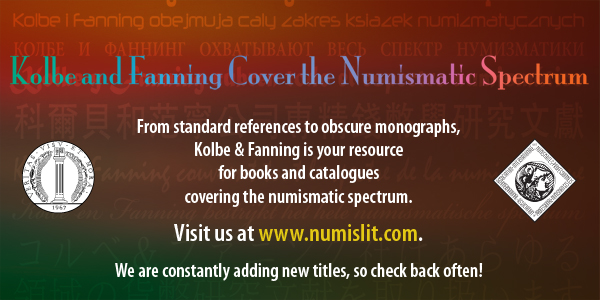
WAYNE'S NUMISMATIC DIARY: DECEMBER 16, 2012
Last Saturday (December 8) I hosted an event for kids at the Annandale, VA coin show, with assistance from Jon Radel, Tom Kays and Mike Hudson. Tom donated some nice type coin lots for our auction, including Flying Eagle Cents. My topic was U.S. Type Coin collecting, and I quizzed the crowd with PowerPoint images of coins. They really knew their stuff, and I didn't stump them on a single one, not even a Wreath Cent.
I also discussed coin denominations, which I used as a stepping stone to talk about sales tax tokens and the Nova Constellatio pattern set and the proposed denomination of Mills (1/1000 of a dollar). Some of the sales tax tokens were denominated directly in mills, or other fractions of a cent. I diverged into the tale of how John Ford recognized and purchased the copper five mill piece and reunited it with the silver patterns after the Garrett sales. After wrapping up the sales tax tokens I told them about the ration tokens of WWII.
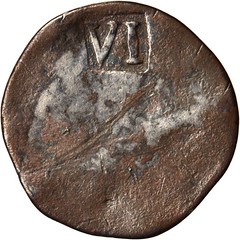 The last odd denomination coin I showed was the recently sold New England sixpence. They even got that right, although the first kid to respond was reading the Roman numerals as a seven rather than a six. I told them to story of how the coin had been dug up on a potato farm and had them guess what the piece sold for. Guesses were all over the map from $10,000 to $10 million. It sold for $430,000.
The last odd denomination coin I showed was the recently sold New England sixpence. They even got that right, although the first kid to respond was reading the Roman numerals as a seven rather than a six. I told them to story of how the coin had been dug up on a potato farm and had them guess what the piece sold for. Guesses were all over the map from $10,000 to $10 million. It sold for $430,000.
The auction was a hit, leading off with two lots I culled from a nice donation of tokens from Dave Schenkman. Lot 1 was a starter set of about 35 different sales tax tokens, and Lot 2 was a group of about 15 different OPA ration tokens, both red and blue.
My son Tyler missed out - he wasn't interested in going this time, so I flew solo. He loves animals so I brought home some coins picturing animals. "Are there any dogs?" "Not in this batch..." He wasn't interested. So much for expanding his horizons - gotta be dogs or nothin'. Anyway, it was a great morning to be with the kids and see their enthusiasm and knowledge.
My next numismatic adventure was only semi-numismatic. The December meeting of my Northern Virginia numismatic social group, Nummis Nova, was held at the Mt Vernon Inn on the historic estate of George Washington. Spouses and guests are invited, and everyone gets dressed up a bit. I was flying solo again. My wife was too worn out from preparing to celebrate the holidays that she didn't feel like going out to celebrate them.
I got there about six, and met Chris Neuzil and his wife Sandy in the parking lot. We were ushered into the sitting room where Mike Packard and others were waiting. I'd planned to wear a festive red sweater, but had left it at home accidentally. Gene Brandenburg had a nice red sweater on, and seated next to the fireplace with his white beard he looked for all the world like Saint Nick. When Eric Schena arrived, I told him he'd have to get in line to sit on Santa's lap.
 Tom Kays had a surprise for me - he'd run into a Chinese calligrapher and had him make a poster on cardboard with the name of our group, Nummis Nova. It's in classic Mandarin Chinese. Coincidently, during the night's dinner I received an email from an E-Sylum subscriber in China, Li/Tiesheng.
Tom Kays had a surprise for me - he'd run into a Chinese calligrapher and had him make a poster on cardboard with the name of our group, Nummis Nova. It's in classic Mandarin Chinese. Coincidently, during the night's dinner I received an email from an E-Sylum subscriber in China, Li/Tiesheng.
I lost count, but we had about 25 people seated at three tables in a separate room with an open bar. The confusion was ably organized by Jon Radel, who'd made the arrangements with the restaurant and collected the money to pay the tab.
There was a little numismatic content, but Dave Schenkman brought along a couple items appropriate to the venue and time of year. He writes:
The Mt. Vernon piece is interesting and I’ve never seen another. I purchased it from Joe Levine nearly 40 years ago. The distillery was located in Baltimore but I thought it appropriate to bring it to the dinner, given the name. The other piece is a neat early Christmas medalet.
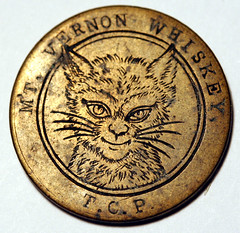
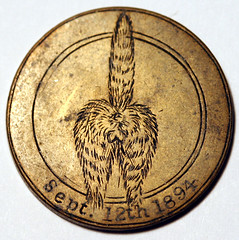
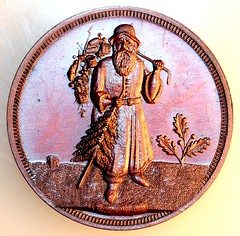
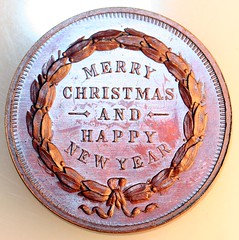
Because of the spouses in attendance in December, we try to keep numismatic content to a minimum. At my suggestion Tom Kays created a great quiz for everyone about George Washington. It was interesting, and tough! It was multiple choice, but there could be more than one correct answer. Here are some samples - I'll post the answers next week. If anyone wants to try the whole quiz I'll email you a copy.
Excellent dinner guests should be well acquainted with their host.
Correct Answers may be none, one, several or all of the multiple choice answers offered.
Question 1. When was George Washington born?
a. In the year 1729.
b. In the year 1731.
c. In the year 1732.
d. In the year 1749.
Question 5. If you had mentioned “the White House” to George Washington he would have told you it was located where?
a. In the District of Columbia.
b. He would not have known, it wasn’t completed until after his death.
c. Along the Pamunky River in New Kent County, Virginia.
d. Along the James River, near Bermuda Hundred.
Question 6. Who would George have said lived in “the White House.”
a. George and Martha Washington.
b. No one since he would not have known about the White House.
c. Mary Ball Washington (George’s Mother)
d. Martha Dandridge Custis.
Question 8. Where was George Washington inaugurated President?
a. In Virginia.
b. In New York.
c. In Philadelphia.
d. In Boston.
Question 19. What was George Washington’s net worth at his death in 1799 dollars?
a. $25 million dollars. b. $8 million dollars. c. $1 million dollars. d. $350,000 dollars.
THE MARK HILLARY 1796 HALF CENT
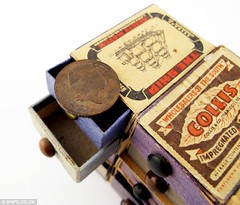 A rare two centuries old coin found in the back of a cupboard after being hidden away for five decades is expected to fetch £30,000 at auction.
A rare two centuries old coin found in the back of a cupboard after being hidden away for five decades is expected to fetch £30,000 at auction.
The half cent American coin, which dates back to 1796 and is one of only 1,400 ever made, will go under the hammer in Salisbury, Wiltshire, next month.
It was part of a collection which once belonged to Oxford student Mark Hillary who was killed in a climbing accident in Greece at the age of 20 in 1963.
The coin, which is still in mint condition, remained hidden in Hilary's homemade cabinet of glued together matchboxes until members of his family found it recently.
It was struck in pure copper at the Philadelphia Mint and designed by the mint's first Chief Engraver Robert Scott.
Daniel Fearon, Woolley and Wallis coin consultant, said: 'A relative brought the matchbox cabinet of coins in and on first inspection there did not appear to be much of interest but then this one coin jumped out.
'I hope it will always be remembered as the Mark Hillary coin.


'Britain is just the place where you could expect to find one. 'The best specimens of American coins have surfaced over the years in British collections.
'There was no local collecting market in America in those early days but in Britain the 1790's was a time when copper coinage and copper trade tokens were widely collected.
'It is the natural place for coins of the former colony to end up.'
Mark Hillary attended both Winchester College and Magdalen College in Oxford and is said to have been well on the way to a first in classical greats when he died.
His passion for coin collecting often took him to the London dealers and the main bulk of his collection was sold at auction a few years ago.
The coin was made by John Smith Gardner, assistant engraver at Philadelphia Mint. Half-cents coins were never popular and mintage was often low as priority was given to the new gold and silver coins.
The coin will be auctioned by Woolley and Wallis in Salisbury on January 22.
To read the complete article, see:
18th century half cent coin that lay at back of cupboard for 50 years expected to reach £30,000 at auction
(www.dailymail.co.uk/news/article-2245556/Coining-18th-century
-half-cent-coin-lay-cupboard-50-years-expected-react-30-000-auction.html)
CALIFORNIA WOMAN INHERITS $7 MILLION GARAGE GOLD HOARD
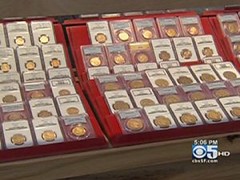 Officials in Carson City, Nevada have declared a California woman the rightful owner of $7.4 million in gold coins found in the home of her late cousin.
Officials in Carson City, Nevada have declared a California woman the rightful owner of $7.4 million in gold coins found in the home of her late cousin.
City Clerk-Recorder Alan Glover said a month's worth of genealogical research determined Arlene Magdanz, a first cousin to the late Walter Samasko Jr., was the only living relative of the man, who died in May.
Her attorney said that the first words out of his client's mouth when she learned of the possible inheritance in September were: 'Oh my God, Oh my God.'
Officials found the treasure at Glover's Nevada home, along with his decaying body, one month later after neighbours complained of a foul smell. He was 69 years old and he left behind just $200 in the bank. He hadn't worked since 1968 and was living off stock investments of $140,000 and $25,000.
The gold coins were stowed away in boxes labeled 'books' in Samasko's garage. Glover had died from heart problems, a coroner found, at least one month before he was discovered.
Leaving no will, and with no known relatives, officials set about tracking down a list of people who had attended Samasko's mother's funeral after she died in 1992, the Las Vegas Sun reported.
She had not spoken to her cousin for a year. The gold, including coins from Mexico, England, Austria and South Africa dating to 1872, was hauled from the garage using a wheelbarrow and truck, then deposited for safekeeping.
To read the complete article, see:
California woman inherits $7million in gold coins found in garage of dead cousin... whom she hadn't spoken to for a YEAR
(www.dailymail.co.uk/news/article-2248280/California-woman-inherits
-7million-gold-coins-garage-dead-cousin--hadnt-spoken-YEAR.html)
To read the earlier E-Sylum article, see: NEVADA MAN DIES WITH GARAGE FULL OF GOLD (www.coinbooks.org/esylum_v15n40a24.html)
Available for immediate sale
Civil War Store Cards
from the estate of
Stephen L. Tanenbaum
Plus: Special Token and Counterstamp News
Ever since I made the announcement that I have acquired a substantial part of the Civil War store card estate collection of the late Stephen L. Tanenbaum excitement has prevailed! The rush to learn more continues as do incoming orders. As I write these words there are still many opportunities, however, specializing in the issues of Connecticut, Illinois (with many rarities), Kentucky (remarkable!), Massachusetts (again notable), Minnesota (a “rare state” with a great selection), New Jersey (a nice selection), New York (amazing!), and Tennessee (opportunities that may never be repeated).
For more than 40 years Steve gathered these, continually improving and upgrading. The vast majority of the tokens are Mint State, many certified by NGC (which Steve was in the midst of doing) and others still in his 2x2 cardboard holders. Rarity-9 (2 to 4 known) tokens abound as do, believe it or not, R-10 (unique) tokens and unlisted varieties.
Numismatic strikes in copper-nickel, overstrikes on other coins, “rare towns,” mint errors, you name it! Each token has been carefully priced to be what I consider to be a very reasonable value. It is significant to say that it has been the rule, not the exception, that those buying tokens have come back to buy more! The quality is remarkable.
If you will send me an e-mail request I will send you my latest list by return e-mail. Nearly all are one-of-a-kind in the estate and are available on a first-come, first served basis.
Special Token and Counterstamp News: Into the spring I will be spending time at my bank sorting through tokens, counterstamped coins (mostly copper cents), and some other items collected since 1955 (!). I will be making a priced list of these. When requesting the CWT list add “QDB tokens too” and when ready I’ll send you a list.
Thank you for your interest!
Box 539
Wolfeboro Falls, NH 03896
Request by e-mail: qdbarchive@metrocast.net
JUNO MONETA, GODDESS OF MONEY
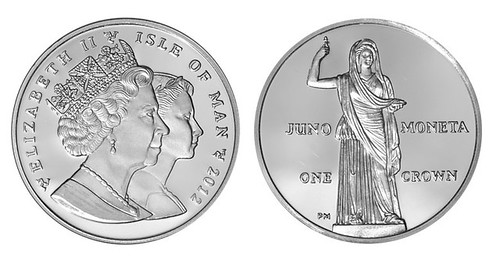
The word money comes from the Latin word moneo, which means ‘ to warn’, and is named after the Roman Goddess, Juno Moneta. Juno, in Roman mythology, was the wife of Jupiter and as such was considered the Queen of Gods and the most powerful goddess. She was originally the Goddess of marriage and childbirth, the protectress of women, the patroness of matronly virtues and the patron Goddess of Rome.
In 390BC, a flock of geese kept in Juno’s sanctuary on Capitoline Hill, saved Rome by warning of an impending invasion by the Gauls. The Roman General, Marcus Furius Camillus, built a temple on the hill in gratitude for the Goddess’ warning. Approximately one hundred years later, the first Roman mint was built adjacent to the temple and the coins, struck with the head of Juno Moneta on the face, were called ‘moneta’. She has since been considered the protector of money and guardian of finances.
In light of the above, Juno Moneta is the perfect choice to feature on this commemorative coin. The design on the coin features a portrait of the Goddess interpreted from a classical statue. The coin features a specially commissioned Double Effigy of Her Majesty Queen Elizabeth II to celebrate her Diamond Jubilee year which shows a portrait of Her Majesty as she appears on current coins, along with a portrait of the Queen based on how she appeared on the first coins of her reign.
The coin is Copper-Nickel , 38.8mm
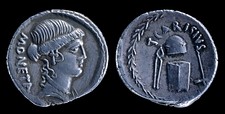 The origins of the modern English words 'money' and 'mint' lie in ancient Rome. In the period of the Roman Republic, from about 300 BC onwards, coins were made near the temple of the goddess Juno Moneta. It was located on the Capitol (the modern Campidoglio), the citadel of Rome. The goddess's name, Moneta ('Warner' or 'Reminder') eventually came to refer to the place where the coins were made, the 'mint', and to its product, 'money', both of which derive ultimately from the Latin word moneta.
The origins of the modern English words 'money' and 'mint' lie in ancient Rome. In the period of the Roman Republic, from about 300 BC onwards, coins were made near the temple of the goddess Juno Moneta. It was located on the Capitol (the modern Campidoglio), the citadel of Rome. The goddess's name, Moneta ('Warner' or 'Reminder') eventually came to refer to the place where the coins were made, the 'mint', and to its product, 'money', both of which derive ultimately from the Latin word moneta.
This coin shows an image of Juno Moneta on the front; her name is written vertically on the left. On the back of the coin are depicted tools associated with metalworking: in the centre an anvil, on the left a pair of tongs and on the right a hammer. Above the anvil is an uncertain object decorated with a wreath. It may be the smith's cap worn by Vulcan, the Roman god of fire and metalworking. Alternatively, the tools shown may be those of an ancient Roman coin-maker, if we interpret the 'cap' as an upper die about to be struck by the hammer onto a blank held by the tongs. The coin was made by the moneyer Titus Carisius.
To read the complete article, see:
Silver denarius showing Juno Moneta
(www.britishmuseum.org/explore/highlights/highlight_objects/
cm/s/silver_denarius_juno_moneta.aspx)
THE WORLD'S STRANGEST CURRENCIES
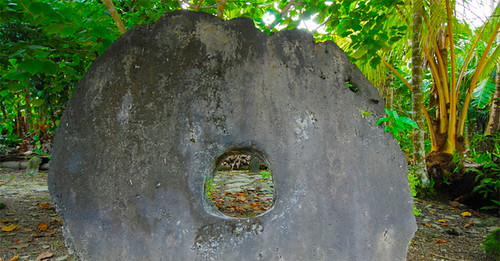
We often think of money as a means of exchange in paper and rounded metal form with conventional denominations. Think again. In the long history of currency, forms of payment that would appear stranger than fiction have appeared. Indeed, before the advent of money, barter was the accepted means of payment where anything could serve as "currency." Here's a brief tour through the quirkier side of the medium's history. Funny money, indeed.
To read the complete article, see: The World's Strangest Currencies (www.investopedia.com/slide-show/strange-currencies/)
FEATURED WEB PAGE: FOUR DOLLAR STELLA
This week's Featured Web Page is from the NGC site, about the Four Dollar Stella (1879-1880).
It was Kasson, though, who was behind another try at an international coinage in 1879. Attempting to appease advocates of both silver and gold, he proposed a “goloid” dollar containing 96% silver, 4% gold, and a four-dollar gold piece of 90% gold, 10% silver. The four-dollar coin was intended to compete globally with a myriad of similarly valued pieces, including the French 20 franc coin, the Spanish 20 pesetas, the Dutch and Austrian 8 florins and the Italian 20 lire.
The four-dollar coin received an entirely new designation: “stella” (Latin for star). This was analogous to the eagle, “both the star and the eagle being national emblems on our coins.” Like the ten-dollar eagle and its smaller and larger counterparts, the stella was to be another denominational unit, and other coins would be expressed in fractions or multiples of it. Along with the stella, patterns for the “goloid” dollar and a “quintuple stella” (metric double-eagle) were struck in 1879.
There were two obverse designs for the stella—one with Flowing Hair engraved by Charles Barber and another with Coiled Hair by George Morgan. Barber’s design depicts Liberty with long, flowing hair; Morgan’s version differs only in that Liberty’s hair is tied in a bun. On both designs, Liberty is encircled by the lettering *6*G*.3*S*.7*C*7*G*R*A*M*S*, stating the proportions of gold, silver and copper in the coin. The reverse features a large five-pointed star as the central motif, with the incuse inscription ONE /STELLA/400/CENT. Both the U.S. motto E PLURIBUS UNUM and the Latin motto DEO EST GLORIA (God is Glorious) circle the star, in turn surrounded by the inscriptions UNITED STATES OF AMERICA and FOUR DOL.
The stella never saw regular production; Congress killed the legislation and only patterns were made, all proofs.
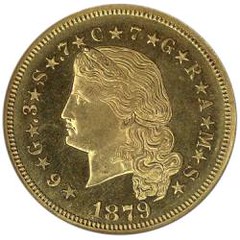

www.ngccoin.com/NGCCoinExplorer/SubCategory.aspx
?SubCatID=60&PopSubCat=Four-Dollar-Stella

